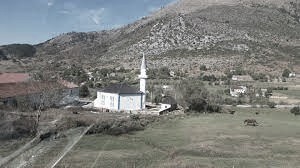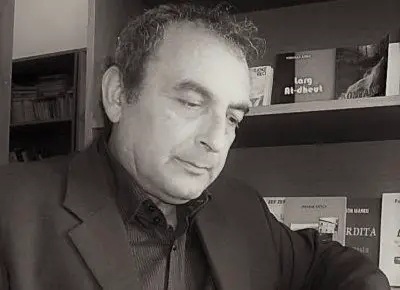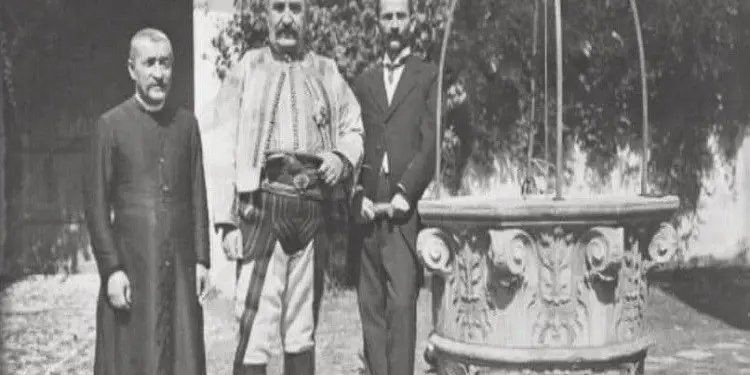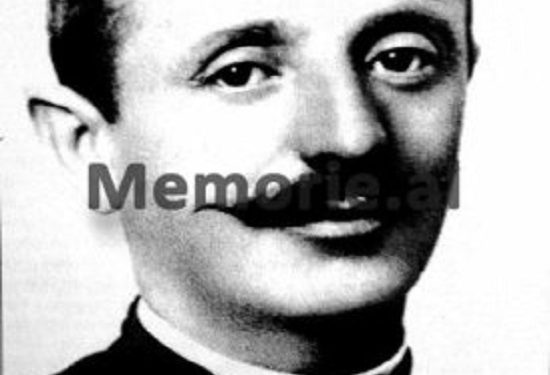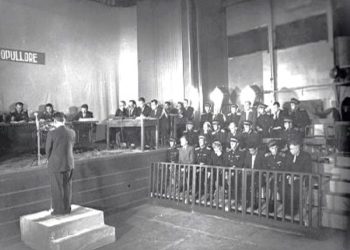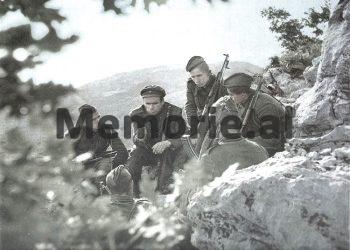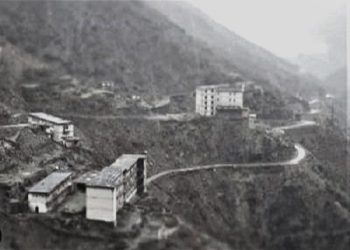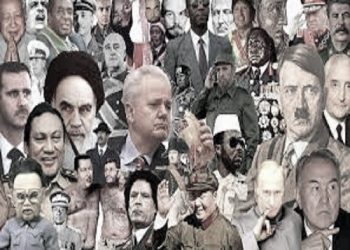From NDUE DEDAJ
-UNIQUE RELIGION OF LURA-
(Or the coexistence of two faiths under one roof)
Memorie.al / Lura has had the good fortune, like no other province of Albania, to contain within it two truly fundamental values, one of which has to do with the miracle of nature (the most beautiful place not only in Albania, but perhaps also in the entire Balkan region) and religious coexistence within the home, as rarely anywhere else in the world. In both of these, she is a double symbol, of natural beauty and of religious harmony. It has been a custom in the Albanian world to honor holy places, regardless of which faith they belonged to. It was important that it was a holy place, waqf/waqf. Stones were not taken there, wood was not cut, and simply religious meditation was done there. If it wasn’t your religion, it was someone else’s. In a village not far from Peshkopia, on the site of an old church, people don’t cut wood, they keep the church name as it was, and why already there, everyone is of the Muslim faith.
The inhabitants of a village near Lezha, with their own money, recently rebuilt the old monument, in respect of the holy place, and why they are all of the Catholic faith. This is tradition, culture, citizenship. A lot has been said and written recently about the church of Mali Bardhë in Kurbin, built with the voluntary contribution of the Muslims of the village. But this should not be seen as a revelation. Those people have always celebrated each other’s religious holidays, without changing their religion, such as St. Michael, etc. This has only made them more friendly and brotherly among themselves.
But it is not only Mali i Bardhi that is like that. Monsignor Frano Illia, in the 60s, wrote that; “In Vinjalle, now there is no Catholic”, but “even though the people of Vinjalle are Mohammedans, they celebrate the feast of St. Nicholas, that of the Holy Mother, and until recently also with friends like the Catholics. On the great Saturday of Pentecost, (just like) the Catholics, at noon they release the oxen, the feast begins. Such traditions have remained since they were Catholic. Vinjallasi have a special devotion to St. Nicholas and his church in their village.” (Frano Illia, Famullia e Milot, 2006, pg. 118.)
But we can also look deeper into history. In early publications, it is written that in the Albanian highlands, it stands out; “the devotion of some Muslim women to the Virgin River, who fast on Saturdays in honor of her and bring flowers and beans in front of the image of Saint Mary”. (A. P. DI Venezia, Histori Serafica, p. 343; quoted according to P. Vinçenc Malaj, Assembly of Arbën 1703, p. 205.)
This is the acceptance of the other, according to the Albanian codes of understanding, and it would be wrong to explain it with; “Albanian’s religion is Albanianism”, which does not move the comma from the cultural context and historical circumstances when it was pronounced. The American researcher, Robert J. Stevens, like Durham and others, writes that; “Albanians are not religious fanatics and their religion does not mean nationality”. (R. Stevens, “Political developments in Albania 1920-1939”, Tirana 2004, p. 9.)
Albanianism, as a high national feeling, does not exclude the religious affiliation of the minority, it is not a religion, and there is no cult institution for it. Therefore, it is good not to exaggerate the patriotic discourses of the Renaissance by confusing them with the socialist discourse of yesterday or today, since there is more than a century in between. But let’s continue among the Albanian religious readings.
Recently, the church of Lura has become new and its caretaker for the three years of construction was a Muslim. Lura is the unique example in the Albanian world, where two faiths coexist in one house. Muslim wife and Catholic husband, one Catholic brother, the other Muslim, Muslim nephew, Catholic uncle, etc. It is no coincidence that Monsignor Nikollë Kaçorri was the son of a Muslim woman.
While the other mentioned priest of the beginning of the 20th century from Kurbini, Dom Pashk Lalpepaj (“Turku”), came from a Mohammedan family. And it is not only Lura like this, but also several other areas, where, so to speak, the faiths met: Catholic and Muslim, as in Selitë, Mat, Pukë, Malësi e Madhe, Lezhë, Gjakovë, etc.
Maybe Lura, can’t be different, but special in everything, like; the queen of Albanian beauty, with seven silver cups in her hands and the inimitable, still-friend, the Albanian Lily (Albanicum Lilium). Lura, like a dream that everyone wants to see and like a magic that everyone wants to touch. Lura that can only be compared to itself. I was a church and a mosque at the same time. With a canon of its own. Her relationship with faith is unique. The people of Lura, wherever they went, when they were asked: “Are you Catholic or Muslim”, they answered: “I am from Lura”. This does not take anything away from the religious affiliation, but proves to the perpetrators their racial identity.
And how did her interfaith relationship work? This is how he describes the house of Vlad, a 70-year-old man from that door. “Our house is well known in Lure. Early on they were all of the Catholic faith. One of her sons, Kola, married a Muslim woman, from the Haldedaj tribe, and had three sons with her, Mata, Biba and Bushi, the first Muslim, the other two Catholics. And so the generations continued in this great family, one Muslim and two more Catholic. We lived in the same house, tower. Mata celebrated Eid with his family (wife and children), Biba and Bushi, Easter with theirs.
When Mata observed Ramadan, the others did the fasting services, including the Catholic part of the house that took care of her. Only his family did not keep a pig and did not bring pork into the house. Even after the great house was divided, the Catholic families descended from it still did not keep pigs, but bought the pork in the bazaar. Since then Vladaj were some Catholics and some Muslims”. (Elez Vladi, Rrëshen, October 2014.)
Understanding, acceptance of the other’s religion, without any concern, the coexistence of people with different faiths, can be seen in the way the family split into two faiths. When the wife told Kole Vlad, that; he wanted to leave the first child to her religion (Muslim), he answered; “yes” and kept his word. This was the case with all the duplicitous families of Lura. In the Mariseni (Koçeku) family, three brothers: Gjoni, Kola and Biba, were Catholics, while Daliu, the brother with them, was Muslim, the four of them from one mother and one grandmother.
Lurasi was aware that faith in his life could never be disruptive, divisive, or divisive. Even though the Muslim religion was introduced by the Ottoman conqueror, with the conversion of Catholics, often violently, the Albanians knew how to “adapt” it to their own codes of harmony, as was possible early on with other faiths. The phenomenon of Muslim girls marrying Catholics and vice versa, extended beyond Lura.
The prince of neighboring Mirdita, Prengë Bibë Doda, was the grandson of Muslims in the family of Ajaz in Lure. The girl was beautiful and Kapidani thought, oh I’ll take her, oh no. Then her people said: “You wanted a prince, you got a prince.” Of course, not all times such marriages have been easy, there have even been kidnappings of girls, conversion of the Muslim woman to the faith of the man, etc. “The grandson of Muslims (of Vlad’s house) was also Monsignor Nikollë Kaçorri. His mother, Hana, a Muslim, married Vokërr Kaçorri in the ‘Fang’ neighborhood of Krejë-Lura and had two sons, Ndreca and Nikolla. When Don Nikola finished school, his uncles brought him a toy, a curler and a used hullie ox. His brother, Ndreca, told him: “What about us, we don’t have a wedding”?! “Yes, this is the priest, and this is his wedding, that’s why we came to congratulate him.” (Elez Vladi, Rrëshen, October 2014.)
“We are confused” they say in Lure. Muslims have also taken wives from Catholics, such as Rajtaj in Krejë-Lure, but also in Fan, etc. So Doçi, a Catholic, took a Muslim wife from Tharri in the Cara tribe, from the Koleci tribe in Lami Madh, took a wife in Gjikolaj, a Muslim from the house of Vladi took a Catholic wife in Selitë (Mirditë), who was also a mixed area in terms of beliefs, since its two villages, which go with Mati, Lami i Madh and Gjoçaj, had Muslim populations, while Zajsi, Tharri and Mëkurthi, with Catholic residents, and a few Muslim families (Cara, Simoni) .
While in the years of “socialism” a wider marital relationship was created between Albanians of different faiths, with mixed Catholic/Orthodox and Muslim marriages, which continues today all day, usually without the wife converting to the husband’s faith.
It’s not just Lura. And Muslim-Catholic marriages are not only late, but also early. The prince of Mirdita, Bibë Doda, had taken a Muslim girl as his wife from Lura. In the Marku Muslim family in Reç i Dibra, a Catholic woman from neighboring Mirdita marries. Xelal Marku, her successor, (a journalist for many years in TVSH), says: “As my grandmother, Hane Mena (Vladi), her people have told me, she was the granddaughter of the Captain of Mirdita – Gjomarku in Orosh.
My grandmother’s mother’s name was Prena Gjomarkaj, but she was called Prena Mirdita. She was married to a noble, smart and brave man from the Bajraktar tribe of Lura, whose name was Kros Mena. From the marriage of Kros Mena with Prena Gjomarkajn, only three daughters were born: Dava Mena, Hane Mena (my grandmother) and Hike Mena.
This unusual marriage between two large and well-known tribes: Gjomark and Mena, who were of different religions (Catholic and Muslim), came after a relationship between them, where it is said that Kapidani fell into a feud with someone and asked Mena, to shelter him until this matter is clarified. Thus, for two years, the Captain was received with generosity and faith by the Bajraktari of Lura – Mena, the time it took to make the agreement (reconciliation) for the enmity that the Captain had. When the captain was about to leave the tower of Mena, he tells the owner of the Recian house that; I, for your hospitality, generosity and loyalty, will make you a friend, without any condition, and gave him a daughter, Prena, who took her as his bride, Kros Mena. She would be my grandmother, who was a woman with a name and a voice, not only in Lure, but also in Dibër. She wore allti in her belt, fought side by side with men, held meetings with men and drank coffee and tobacco with çibuk, even in men’s majlis.
Therefore, you never saw him in the assembly with the women. Totally special. She also had a beautiful portrait, as a film artist, that resembled Marie Logoreci. So briefly about Hane Mena, my esteemed grandmother”. But the typical Lurian-Recian interfaith story in one family would not stop there. Xelali adds: “Today, in my home, I have three religions in coexistence: Catholic (my son is familiar with his daughter-in-law and three children), Muslim (it’s me and my two daughters) and Orthodox, which is the wife – Lefteria. Three religions in one house, where all religious holidays, of all faiths are celebrated”. I have called this youth unity, as it is not an isolated case, but a phenomenon. Thus a Muslim lady from Central Albania was married into a family, with a Catholic father-in-law and an Orthodox mother-in-law.
Or is it not half Catholic and half Muslim and the very name Jelal Marku? Early Catholics and, later converted to Muslims, as fully similar in Mat, Dibër and Kukës, with Muslim names and Catholic surnames. Likewise, Gjon Deda, former chairman of the Mirdita District Executive Committee, was a Catholic, while his brother, Islam Moriseni, was a Muslim, or in a house in Doçi, there were half Muslims and half Catholics. I am mentioning some names: Halit Doçi, Skender Doçi, Ali Doçi, Bib Doçi, Kol Doçi, Ded Doçi, Zef Doçi, Lek Doçi, etc. This is the Albanian family. Just as the opposite happened, in some Catholic families in Mirdita, the surname is Muslim: Haxhia, Beqiri, Xhaferri, Sinani, etc. Explain why this happened…?!
Conversion as a process is understood more than from the letters from the memory of generations, to those of today, who inherit this from their grandparents. In Kukës or Burrel, educated intellectuals say that; conversion was not something desired by their ancestors, because it was carried out with a sword over the head, but they have never forgotten their Catholic roots, showing interesting details about this survival. (S. Dida, P. Palushi, A. Kurti)
How Albanians treat holy places is shown by the biblical pilgrimage to the Holy Church in Laç i Kurbini, where believers go without distinction…! Or in Rubik, where recently we have an all-religious symbol, the only one in the Balkans, created ten years ago, in a stone carved like a cup, in the courtyard of the thousand-year-old church of Rubik. It has its own reading, quite significant, which unites three Abrahamic religions.
Secularism is our opposition to the state, which is also served by faiths, priests, imams, etc. Idriz Jumara explains it as a coincidence or consequence of marriage with two women, accepted by Islam. It is understood that there was an agreement that the children to be born would have the religious affiliation of the mother.
An old Albanian city like Shkodra, among the emblems of Albanian civilization, has both Catholic cemeteries and Muslim cemeteries, in a way; “Catholic neighborhood” and “Muslim neighborhood”, but we are putting the latter in quotes, as they are not official. We are not bringing this fact to open a debate, whether we should continue like this in the future or not? Let’s not even draw attention to how the teacher of “religion” at school would answer this question in front of the students? Let’s not even notice those civil communities, where Catholics, Muslims, Orthodox, people of other faiths and non-believers, are buried in the same public cemeteries, without any problem, etc., as this would be a separate analysis.
Just one question we would have above, what happens in a mixed family (Muslim man, Catholic woman or vice versa) when they die? Where are they buried? One in the Catholic cemetery, the other in the Muslim cemetery? They had their lives together; do you think death would separate them? Still further, how did it used to happen in Lura, in such laramanized families in terms of faith, the Catholic man-Muslim woman?
Note: I would only like evidence, facts as it happened and is happening and not comments. Meditation yes… but also reflection, cultural, social! Memorie.al





